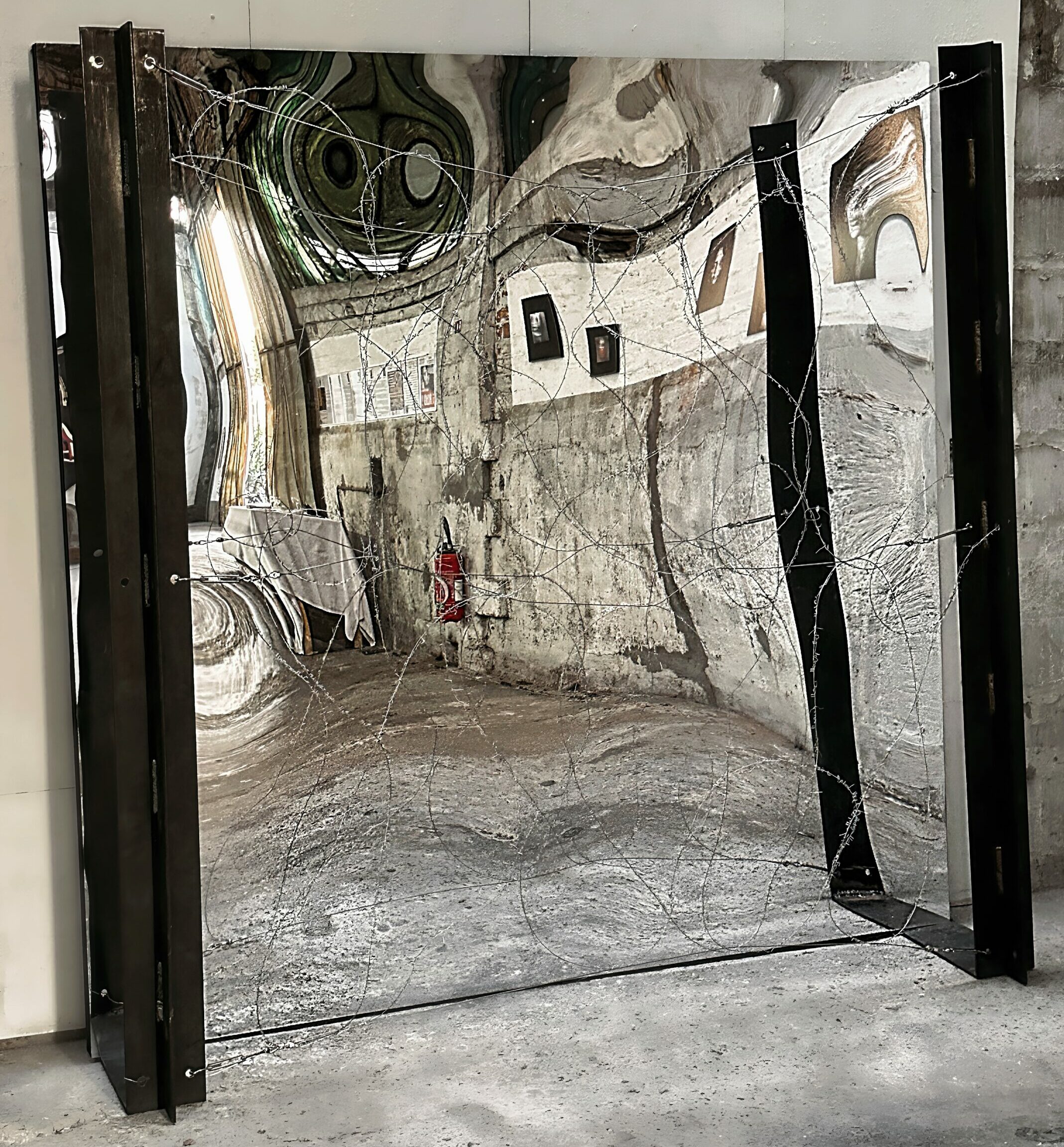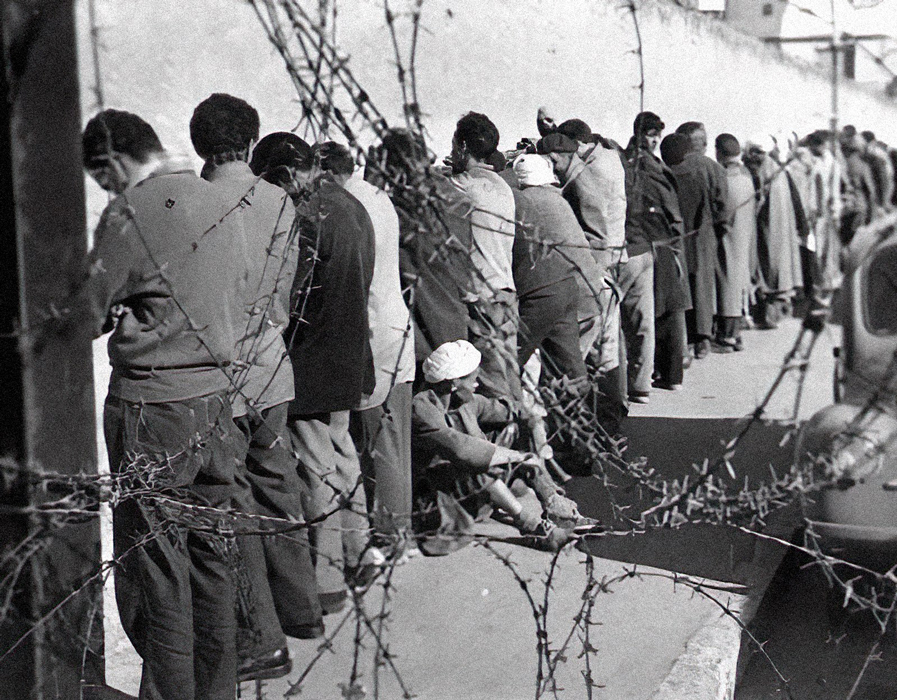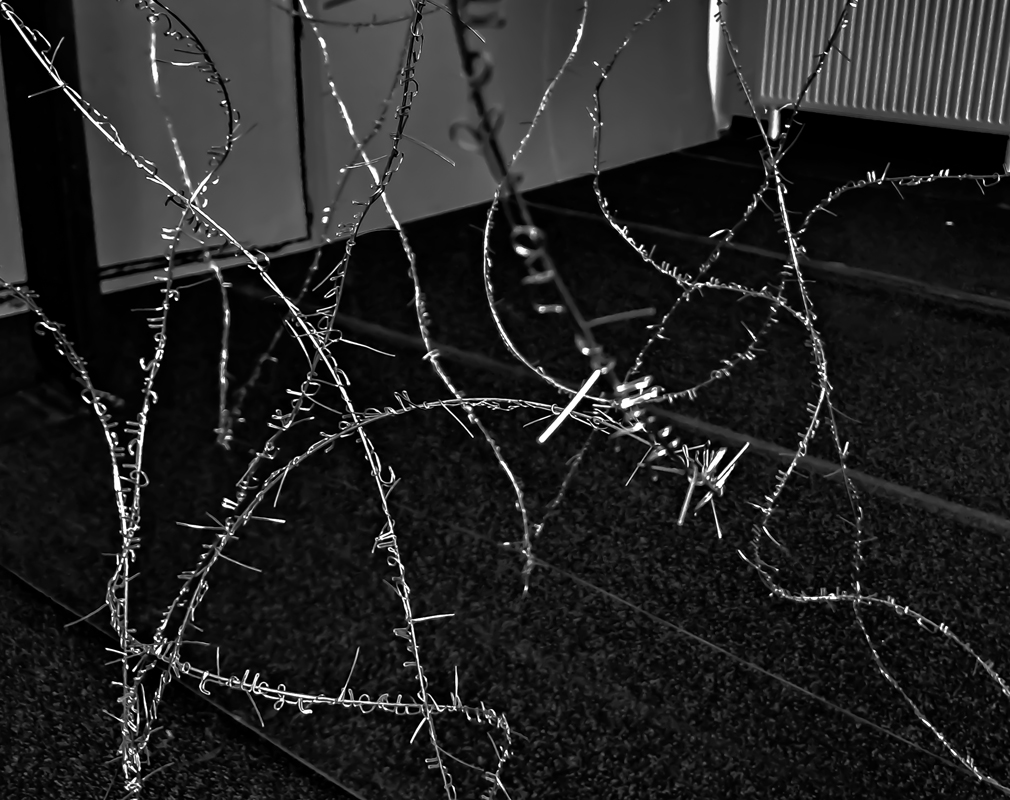Les
barbelés
de Sétif.
الأسلاك
الشائكة
في
سطيف
تركيب 200 × 200 × 60 سم
سم، فولاذ، حديد، خشب ومرآة PMMA،
2022
Installation 200 x 200 x 60 cm,
Acier, fer, bois et PMMA miroir
2022
Un déni de mémoire : le 8 mai 1945
« Ces poèmes ont été écrits lorsque j’avais quinze ans, avant et après la manifestation du 8 mai 1945. J’étais interne au collège de Sétif. Ce jour-là, c’était la fête, la victoire contre le nazisme. On a entendu sonner les cloches, et les internes ont été autorisés à sortir. Il était à peu près dix heures du matin. Tout à coup j’ai vu arriver au centre de la ville un immense cortège. C’était mardi, jour de marché il y avait beaucoup de monde, et même des paysans qui défilaient avec leurs vaches… A la tête du cortège, il y avait des scouts et des camarades du collège qui m’ont fait signe, et je les ai rejoints, sans savoir ce que je faisais. Immédiatement, ce fut la fusillade, suivie d’une cohue extraordinaire, la foule refluant et cherchant le salut dans la fuite. Une petite fille fut écrasée dans la panique. Ne sachant où aller, je suis entré chez un libraire. Je l’ai trouvé gisant dans une mare de sang. Un ami de mon père qui passait par là me fit entrer dans un hôtel plein d’officiers qui déversaient des flots de propos racistes. Il y avait là mon professeur de dessin, une vieille demoiselle assez gentille, mais comme je chahutais dans sa classe, ayant parlé une fois de faire la révolution comme les Français en 1789, elle me cria : « Eh bien, Kateb, la voilà votre révolution, alors, vous êtes content ? » J’ai filé sans répondre. Il y avait partout des soldats en position de tir. Plus question de retourner au collège. (…) Le 13 mai, au matin, j’ai été arrêté par des inspecteurs qui m’ont conduit à la prison de la gendarmerie. Et là, j’ai commencé à comprendre les gens qui étaient avec moi, les gens du peuple. Autour de la prison, on entendait les coups de feu, les exécutions sommaires avaient lieu en plein jour. Devant la mort, on se comprend, on se parle plus et mieux. Quelques jours après, nous avons été transférés à la prison de Sétif, puis au camp de concentration, un immense terrain vague entouré de barbelés, où je suis resté plusieurs mois. A ma libération, j’ai traversé une période d’abattement. J’étais exclu du collège, mon père agonisait, et ma mère perdait la raison. Je restais enfermé dans ma chambre, les fenêtres closes, plongé dans Baudelaire. »
C’est ainsi que Kateb Yacine, célèbre écrivain algérien, relate dans Soliloques, monologue poétique écrit en prison la manifestation de Sétif, après laquelle il est emprisonné à l’âge de 15 ans seulement.
Il illustre en effet à quel point les émeutes du 8 mai 1945 furent structurantes pour cette génération. Le 8 mai 1945 est une date paradoxale ; alors que l’euphorie gagne la France qui célèbre la victoire des alliés sur l’Allemagne Nazie, en Algérie, encore territoire français, cette journée demeure funeste. Ayant participés à l’effort de guerre et combattus aux côtés des soldats français, les nationalistes algériens appellent les citoyens à manifester pour la libération de Messali Hadj¹ et pour l’indépendance de l’Algérie.
La France était enfin libre, elle accorderait ainsi sa liberté à l’Algérie. Le sous-préfet autorise les manifestations à condition qu’aucun drapeau algérien ne soit brandit. Seulement, un jeune scout musulman du nom de Bouzid Saâl y déroge. Il est exécuté par un policier. De violentes émeutes éclatent. La foule se déchaine sur des Européens : 102 Français d’Algérie sont assassinés. De là, une répression féroce se met en place menée par le général Duval : couvre-feu, circulation interdite, l’aviation est même mobilisée. Des villages entiers sont rasés, des civils exécutés. Les émeutes s’étendent à Guelma et Kherrata et durent jusqu’au 22 mai.
Elles marquent ainsi un tournant décisif pour les Algériens qui réalisent que l’indépendance de l’Algérie ne se gagnera que par le combat. Le bilan est sombre. Les Historiens décomptent environ 45 000 morts du côté algérien.
Le trauma en reflet
Outre la violence de la répression, la peine est double, ces massacres ayant été occultés de la mémoire nationale.
Lorsque Zohra Hassani découvre une photographie d’archive sur le 8 mai 1945 en Algérie, elle décide d’en faire une installation. Réalisée par un anonyme, la photographie ne rappelle que trop les pratiques nazies. Elle montre une dizaine d’Algériens parqués, fronts contre un mur, alignés tel du bétail, comme dans l’attente du peloton d’exécution. Plus choquant encore un poteau entouré de barbelés sépare le photographe et les prisonniers.
Dans cette œuvre, intitulée Les Barbelés de Sétif, Zohra Hassani propose une expérience immersive. En effet, le spectateur se retrouve face à du plexiglass de 2 mètres à l’effet miroitant. Elle reconstitue les dimensions des poteaux et des barbelés de la photographie d’archive.
Passant des mois à travailler minutieusement le fil métallique. Ce dernier recouvre toute la surface du miroir et reproduit en calligraphie arabe les 99 noms d’Allah. Ainsi, lorsque le spectateur voit son reflet il est distancé par les barbelés. Comme pour matérialiser la superposition du passé et du présent, les poteaux et les barbelés au premier plan produisent une distorsion supplémentaire de notre reflet, le rendant quasiment inatteignable bien que suffisamment clair.
Elle retranscrit ce que les Soufis appellent le dikhr, exercice spirituel qui permet d’entrer dans un état de conscience modifié. Les barbelés se transforment dès lors en outils de dépassement du trauma. Telle une catharsis, ce choix n’est pas anodin : l’artiste fait appel aux pratiques de ses ancêtres et à des moyens spirituels pour surmonter les violences subies.
D’une grande puissance et, à bien des égards, universelle cette œuvre s’érige en espace de réflexion sur nos mémoires traumatiques, nous interrogeant de manière aigue : comment transcender nos traumatismes ? Doit-on s’y plonger, y regarder de plus près, s’en éloigner ? Nos fenêtres sur le passé sont-elles sources de clarté ? Comment surmonter nos douleurs mémorielles tout en les transmettant ? Et enfin, comment triompher des traumatismes qui engagent nos corps et qui touchent des générations successives ?
___________
¹ Messali Hadj, chef du PPA (Parti du Peuple Algérien) est arrêté en avril 1945 et déporté au Gabon. Son arrestation créée l’émoi et provoque les manifestations de mai 1945.
Fadila Yahou | Historienne et critique d’art, docteure en histoire de l’art.


إنكار الذاكرة: 8 مايو 1945
« كتبت هذه القصائد عندما كان عمري خمسة عشر عامًا، قبل وبعد مظاهرة 8 مايو 1945. كنت مقيماً في كلية سطيف. في ذلك اليوم، كان هناك احتفال بالنَّصر ضد النازية. سمعنا أجراس الكنائس، وسُمح للطلاب بالخروج. كانت السَّاعة حوالي العاشرة صباحًا. فجأة، رأيت موكبًا ضخمًا يصل إلى وسط المدينة. كان ذلك خلال يوم الثلاثاء، يوم السوق، وكان هناك الكثير من الناس، حتى الفلاحين الذين كانوا في مسعى مع أبقارهم… في مقدمة الموكب كان هناك كشافون وزملاء من الكلية الذين أشاروا لي، فانضممت إليهم دون أن أعرف ما الذي كنت أفعله. على الفور، بدأ إطلاق النار، تلاه فوضى هائلة، حيث تراجعت الحشود بحثًا عن النجاة. تم سحق طفلة صغيرة في الفوضى. لا أعرف إلى أين أذهب، فدخلت عند بائع كتب. وجدته ملقى في بركة من الدماء. أدخلني أحد أصدقاء والدي إلى فندق مليء بالضباط الذين كانوا يسهبون في استخدام عبارات عنصرية. وكانت هناك أستاذة الرسم الخاصة بي، وهي سيدة مسنّة لطيفة، ولكن بما أنني كنت مشاغبًا في صفها، عندما تحدثت ذات مرة عن القيام بثورة مثل الفرنسيين في 1789، صاحت في وجهي: « إذن يا كاتب، هذه هي ثورتك، هل أنت سعيد الآن؟ » تركتها دون أن أجيب. كان هناك جنود في كل مكان في وضعيَّةٍ لإطلاق النار. لم يكن بإمكاني العودة إلى الكلية… في صباح 13 مايو، تم اعتقالي من قبل المفتشين الذين أخذوني إلى سجن الدرك. ومن هناك، بدأت أفهم الذين كانوا معي، هؤلاء الذين من الشعب. كان هناك إطلاق نار حول السجن، كانت الإعدامات تتم في وضح النهار. أمام الموت، بدأنا نفهم بعضنا البعض، وتحدثنا بشكل أفضل. بعد أيام، تم نقلنا إلى سجن سطيف، ثم إلى معسكر اعتقال، وهي أرض شاسعة محاطة بأسلاك شائكة، حيث بقيت عدة أشهر. بعد إطلاق سراحي، مررت بفترة من الانهيار. تم استبعادي من الكلية، وكان والدي في حالة احتضار، ووالدتي كانت تفقد عقلها. كنت أغلق نوافذ غرفتي وأغرق في كتب بودلير »..
هذه هي الطريقة التي يروي بها كاتب ياسين، الكاتب الجزائري الشهير، في « مونولوجات » (أو « التهويمات »)، المظاهرات في سطيف، بعد أن تم سجنه عن عمر 15 سنة فقط.
بالفعل، يوضح كيف كانت أحداث 8 مايو 1945 محورية لهذا الجيل. إن 8 مايو 1945 هو تاريخ متناقض؛ ففي الوقت الذي تحتفل فيه فرنسا بانتصار الحلفاء على ألمانيا النازية، كانت الجزائر، وهي لا تزال تحت الاحتلال الفرنسي، تشهد يومًا مشؤومًا. وبعد أن بذل الوطنيون الجزائريون جهودًا في الحرب وقاتلوا إلى جانب الجنود الفرنسيين، دعا القادة الجزائريون إلى التظاهر من أجل إطلاق سراح مصالي الحاج¹ ومن أجل استقلال الجزائر.
كانت فرنسا أخيرًا حرة، وكان من المتوقع أن تمنح الجزائر استقلالها. وافق نائب الحاكم على السماح بالتظاهرات بشرط ألا يتم رفع أي علم جزائري. ولكن، خالف شاب كشاف مسلم يُدعى بوزيد سعال هذا الشرط، فأعدمه شرطي. واندلعت أعمال شغب عنيفة، وهاجمت الحشود الفرنسيين: قُتل مائة واثنين فرنسيَّين من الجزائر. ومن ثمَّ، بدأت حملة قمع شديدة بقيادة الجنرال دوفال: حظر تجول، ومنع التجول، حتى أن الطائرات تم تجهيزها، كما تمَّ تدمير قرى بأكملها، وأعدم مدنيون. امتدت أعمال الشغب إلى قالمة وخَرَّاطة واستمرت حتى 22 مايو.
لقد شكلت تلك الأحداث نقطة فارقة في التاريخ، حيث أدرك الجزائريون أن استقلال الجزائر لن يتحقق إلا بالنضال. الحصيلة كانت قاتمة، حيث يقدر المؤرخون أن حوالي 45 ألف جزائري لقوا حتفهم.
الصدمة منعكسةً
إلى جانب عنف القمع، كانت المأساة مضاعفة، حيث تم طمس هذه المجازر من الذاكرة الوطنية. عندما اكتشفت زهراء حساني صورة أرشيفية من أحداث 8 مايو 1945 في الجزائر، قررت أن تخلق منها تركيبًا فنيًا. الصورة التي التقطها مجهول، تذكرنا بالممارسات النازية. تظهر فيها مجموعة من الجزائريين محشورين، وجباههم على الجدران، مصطفين مثل الأبقار، في انتظار الإعدام. الأكثر صدمة كان وجود عمود محاط بأسلاك شائكة يفصل بين المصور والسجناء.
في هذا العمل الذي يحمل عنوان « أسلاك شائكة في سطيف »، تقدم زهراء حساني تجربة غامرة. يجد المشاهد نفسه أمام لوح من الأكريليك بارتفاع مترين يعطي تأثيرًا عاكسًا. وتعيد تكوين أبعاد الأعمدة والأسلاك الشائكة كما في الصورة الأرشيفية.
من خلال عملها أشهرًا على الأسلاك المعدنية، تغطي الأسلاك سطح المرآة بالكامل وتكتب عليها 99 اسمًا من أسماء الله بالخط العربي. عند رؤية المشاهد نفسه على المرآة، سينتابه إحساس كما لو الأسلاك الشائكة تفصله عن صورته. وكأنها تجسد التداخل بين الماضي والحاضر. إنَّ الأعمدة والأسلاك تصنع غرابة إضافيَّة لانعكاس صورتنا تجعلها رغم كونها واضحة صورة محجوبة.
إنها تعيد صياغة ما يسميه الصوفيون بـ »الذكر »، وهو تمرين روحي يسمح بالدخول في حالة من الوعي متغيرة. تتحول الأسلاك الشائكة بذلك إلى أدوات لتجاوز الصدمة. وكأنها عملية تطهير نفسي، فهذا الاختيار ليس عشوائيًا: إذ يستدعي الفنان ممارسات أسلافه ووسائل روحية لتجاوز العنف الذي تعرض له.
يتشكّل هذا العمل ذو القوة العظيمة والطابع العالمي في جوانب عديدة فضاءً للتأمل في ذكرياتنا المؤلمة، ويدفعنا لنطرح تساؤلات حادة: كيف يمكننا تجاوز صدماتنا؟ هل يجب أن نغوص فيها، ننظر إليها عن كثب، أم نبتعد عنها؟ هل نوافذنا على الماضي تُعدّ مصدرًا للوضوح؟ كيف نتغلب على آلامنا المرتبطة بالذاكرة بينما ننقلها للآخرين؟ وأخيرًا، كيف ننتصر على الصدمات التي تؤثر على أجسادنا وتمتد لتطال أجيالًا متعاقبة؟
___________
¹ مصالي الحاج، زعيم حزب الشعب الجزائري، تم اعتقاله في أبريل 1945 ونفي إلى الغابون. وكان اعتقاله سببًا في اندلاع مظاهرات مايو 1945.
فاضلة ياهو | مؤرخة وناقدة فنية، دكتورة في تاريخ الفن

The
barbed wire
of Sétif.
Installation 200 x 200 x 60 cm
Steel, iron, wood and mirror PMMA.
2022
A denial of memory: May 8, 1945
« These poems were written when I was fifteen, before and after the May 8, 1945 demonstration. I was a boarder at Sétif secondary school. It was a day of celebration, a victory against Nazism. The bells rang, and the boarders were allowed out. It was around ten in the morning. Suddenly, I saw a huge procession arrive in the center of town. It was Tuesday, market day, and there were a lot of people, even some farmers marching with their cows… At the head of the procession, there were some scouts and school friends who waved to me, and I joined them, not knowing what I was doing. Immediately there was shooting, followed by an extraordinary crush as the crowd poured back, seeking salvation in flight. A little girl was crushed in the panic. Not knowing where to go, I entered a bookseller’s shop. I found him lying in a pool of blood. A friend of my father’s who happened to be passing by let me into a hotel full of officers spouting racist rhetoric. There was my art teacher, an old lady, nice enough, but as I was heckling in her class, having once talked about making a revolution like the French did in 1789, she shouted at me: “Well, Kateb, here’s your revolution, so, are you happy?” I ran off without answering. Soldiers were in firing positions everywhere. Going back to school was out of the question. (…) On the morning of May 13, I was arrested by inspectors who took me to the gendarmerie prison. And there I began to understand the people who were with me, the common people. Around the prison, you could hear the gunshots, the summary executions were taking place in broad daylight. In the face of death, we understood each other, we spoke to each other more and better. A few days later, we were transferred to Sétif prison, then to the concentration camp, a huge wasteland surrounded by barbed wire, where I stayed for several months. When I was released, I went through a period of despondency. I was expelled from school, my father was dying and my mother was losing her mind. I stayed locked in my room with the windows shut, immersed in Baudelaire. »
In Soliloques, the famous Algerian writer Kateb Yacine recounts the Sétif demonstration, after which he was imprisoned at the age of just 15.
It illustrates the extent to which the riots of May 8, 1945 were structuring for this generation. May 8, 1945 was a paradoxical date: while France celebrated the Allied victory over Nazi Germany with euphoria, in Algeria, still a French territory, the day was a sad one. Having participated in the war effort and fought alongside French soldiers, Algerian nationalists called on citizens to demonstrate for the release of Messali Hadj¹ and for Algerian independence.
France was free at last, and would thus grant its freedom to Algeria. The sub-prefect authorized the demonstrations on condition that no Algerian flags were flown. However, a young Muslim scout by the name of Bouzid Saâl broke this condition. He was executed by a policeman. Violent riots broke out. The mob lashes out at Europeans: 102 French Algerians are murdered. From there, a ferocious crackdown began, led by General Duval: curfews, traffic bans, even the air force was mobilized. Entire villages were razed to the ground, and civilians executed. The riots spread to Guelma and Kherrata and lasted until May 22.
They marked a decisive turning point for the Algerians, who realized that Algerian independence could only be won through fighting. The toll was grim. Historians count some 45,000 deaths on the Algerian side.
The reflected trauma
In addition to the violence of the repression, the pain is twofold, as these massacres have been obscured from the national memory.
When Zohra Hassani came across an archive photograph of May 8, 1945 in Algeria, she decided to turn it into an installation. Taken by an anonymous person, the photograph is all too reminiscent of Nazi practices. It shows a dozen Algerians penned up, foreheads against a wall, lined up like cattle, as if awaiting the firing squad. Even more shocking, a post surrounded by barbed wire separates the photographer and the prisoners.
In this work, entitled Les Barbelés de Sétif, Zohra Hassani offers an immersive experience. The viewer is faced with 2-metre-high Plexiglas with a shimmering effect. She reconstitutes the dimensions of the posts and barbed wire in the archive photograph.
Spending months painstakingly working the wire. The wire covers the entire surface of the mirror and reproduces the 99 names of Allah in Arabic calligraphy. So when the viewer sees his reflection, he is distanced by the barbed wire. As if to materialize the superimposition of past and present, the poles and barbed wire in the foreground further distort our reflection, rendering it almost unreachable though sufficiently clear.
It transcribes what Sufis call the dikhr, a spiritual exercise that enables us to enter a modified state of consciousness. The barbed wire becomes a tool for overcoming the trauma. Like a catharsis, this choice is not insignificant: the artist calls upon the practices of her ancestors and spiritual means to overcome the violence she has suffered.
Powerful and, in many ways, universal, this work is a space for reflection on our traumatic memories, asking us acute questions: how can we transcend our traumas? Should we immerse ourselves in them, take a closer look or distance ourselves from them? Are our windows on the past a source of clarity? How can we overcome the pain of our memories and pass them on? And finally, how can we overcome the traumas that engage our bodies and affect successive generations?
___________
¹ Messali Hadj, leader of the PPA (Algerian People’s Party) was arrested in April 1945 and deported to Gabon. His arrest caused a stir, leading to the demonstrations of May 1945.
Fadila Yahou | Historian and art critic, PhD in art history.



